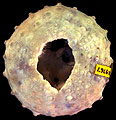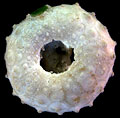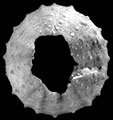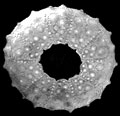|
Diagnostic Features
|
-
Test inflated, depressed above and below.
-
Apical disc large, pentagonal, up to half test diameter in length, extending slightly into posterior interambulacrum. Plates not bound to corona, always missing; presumed monocyclic.
-
Ambulacra straight; plating polygeminate (5 elements to a plate), compounded in phymosomatid style. Pore-pairs undifferentiated; forming arcs across entire length of ambulacrum. No phyllodes.
-
A single primary tubercle to each compound plate; additional small secondaries and granules forming zig-zag line down perradius.
-
Interambulacral plates wider than tall; with a single primary tubercle, positioned centrally and scattered secondaries and granules interradially at the ambitus, but a well developed naked interradial zone present aborally, expanding towards the apex.
-
Tubercles imperforate and crenulate; on ambital and adoral plate the areole and lower part of boss typically radially striated.
-
Peristome small, circular, rather deeply sunken, with small, but clearly defined buccal notches with thickened lip; no tag.
-
No sphaeridial pits; no basicoronal interambulacral plate.
-
Spines less than test length; simple, tapering to a point distally; with thin, smooth cortex.
-
Lantern unknown.
|
|
Distribution
|
Upper Cretaceous (Cenomanian-Maastrichtian), Europe, North Africa, Russia.
|
| Name gender |
feminine |
| Type |
Cyphosoma radiata Sorignet, 1850, p. 28, by original designation.
|
| Species Included |
-
G. radiata (Sorignet, 1850); Cenomanian-Santonian, Europe.
-
G. batnensis (Cotteau, 1864); Turonian, North Africa.
-
G. spatulifera (Forbes, in Dixon, 1850); Santonian, Europe.
-
G. wetherelli (Woodward, 1856); Santonian, England.
-
G. middletoni (Woodward, 1856); Campanian-Maastrichtian, Europe.
-
G. pseudoradiata (Schluter, 1881); Santonian-Maastrichtain, Europe.
-
G. rejaudryi (Cotteau, 1894); Campanian, France
|
| Classification and/or Status |
Euechinoidea, Phymosomatoida, Phymosomatidae.
|
| Remarks |
Distinguished from Cosmocyphus only by complete lack of biserially arranged pore-pairs adapically. Distinguished further from Phymosoma by the sunken peristome and lack of phyllodes.
The type species of Gauthieria has large primary tubercles that fill the plate. Forms with wider interambulacral plates and distinct adradial and interradial bands of granules are better treated as Miocyphosoma Pomel.
Lambert, J. 1888. Note sur un nouveau genre d’échinide de la Craie de l’Yonne. Bulletin de la Société des Sciences historiques et naturelles de l’Yonne, 42(2), 1-14.
Smith, A. B. & Wright, C. W. 1996. British Cretaceous Echinoids. Part 4, Stirodonta 3 (Phymosomatidae, Pseudodiadematidae) and Camarodonta. Monograph of the Palaeontographical Society (publication no. 602, part of vol. 150), 268-341, pls 93-114.
|







